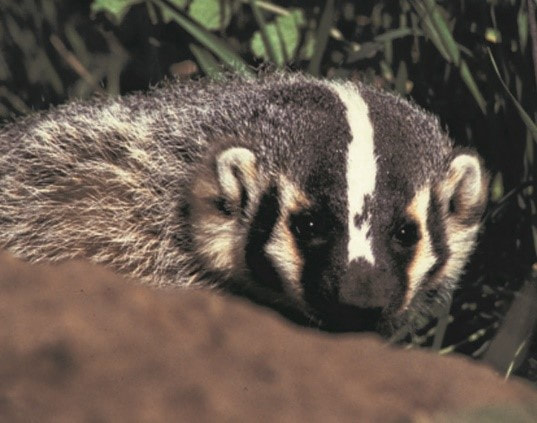|
By Doug Chafa
(Please note this post is part of the Loess Country series) Named from the French word “becheur” which means, “digger,” badgers live in grasslands and do well on the edges of fields and forests. While they are found in all 99 of Iowa’s counties, badgers are more numerous in southern and western Iowa, and are particularly attracted to the native prairie, pasture, oak woodlands and farmland in the loess hills. This iconic grassland predator is armed with 2 ½-to 3-inch claws on its front paws and known for its powerful and fierce disposition. This mammal has a grizzled gray fur color with short stout legs. Its facial markings are distinct, with black badges and white stripes on its cheeks and a white stripe from the nose to the neck. Its ears are set wide on the side of its head. It is primarily nocturnal and fossorial, which means spending time underground in dens. These fearless carnivores are in the mustelidae family that includes weasels and mink, and have the musky odor common among the members of this family. Badgers have been known to eat gophers, ground squirrels, mice, snakes, frogs, and toads and are one of the few predators of skunks. They will eat ground nesting birds, their eggs, and nestlings and will scale banks to dig out and eat bank swallow nestlings or eggs. Badgers can dig a large number of burrows searching for pocket gophers. While the burrows can be hazards to machinery and livestock, badgers do provide a significant amount of rodent control. Mating season stretches from late summer into the fall. Badgers have delayed implantation where the fertilized embryo doesn’t start development until February. Two to three kits are born early in the spring, blind and covered with fur. Their eyes open at four weeks and the kits are weaned at eight weeks. The young disperse late summer through early fall and can be spotted during the day. The young are less alert to roads and vehicles so many are hit on highways. Instead of hibernating, badgers use long cycles of sleepiness during the winter which reduces their expenditure of energy and need to forage. They can be seen in the winter as they occasionally exit their dens on days when the temperature is above freezing. Badgers have a well-earned reputation as being aggressive and fierce. They snarl, hiss, and growl when confronted, often making a series of short bluff charges at perceived threats before retreating to the safety of a den. I stumbled upon a pair of fighting badgers as a kid and it was one of the loudest and most savage fights I have ever witnessed. They were oblivious to my dog and me as they circled and snarled and tangled with each other with vicious bites and wrestling. Badgers have very loose skin which allows them to turn and bite back, even when an attacker is biting and pulling on them. Adult females weigh up to 14 pounds and males can hit 30 pounds. They have few predators in western Iowa, but in western states, mountain lions, wolves, and bears have been known to kill adult badgers. Young badgers are occasionally taken by golden eagles and coyotes. The badger’s earthworks are useful to other wildlife and plants. Some animals, like coyotes, groundhogs, and foxes, make use of badger dens and burrows. Burrowing owls have been known to nest in badger burrows. Snakes and toads use the burrows to cool during the heat of warm days. Mounds of dirt excavated by badger burrowing create bare soil for prairie seeds to colonize. So while you may or may not ever see a badger, most likely you’ve seen its handiwork.
0 Comments
Leave a Reply. |
Archives
June 2024
Categories
All
|
Address712 South Highway Street
P.O. Box 189 Oakland, IA 51560 |
ContactPhone: 712-482-3029
General inquiries: [email protected] Visit our Staff Page for email addresses and office hours. |


 RSS Feed
RSS Feed